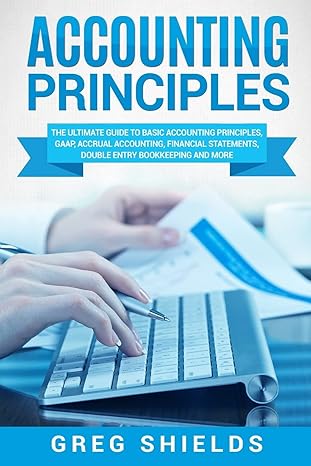Answered step by step
Verified Expert Solution
Question
1 Approved Answer
M7-20 to 22 (Algo) (Supplement 7A) Calculating Cost of Goods Sold and Ending Inventory under Perpetual FIFO, LIFO, and Weighted Average Cost [LO 7-S1] In
M7-20 to 22 (Algo) (Supplement 7A) Calculating Cost of Goods Sold and Ending Inventory under Perpetual FIFO, LIFO, and Weighted Average Cost [LO 7-S1] In its first month of operations, Literacy for the Illiterate opened a new bookstore and bought merchandise in the following order: (1) 400 units at $9 on January 1, (2) 600 units at $10 on January 8, and (3) 790 units at $11 on January 29. Assume 990 units are on hand at the end of the month. M7-20 (Algo) (Supplement 7A) Calculating Cost of Goods Sold and Ending Inventory under Perpetual FIFO [LO 7-S1] Calculate the cost of goods available for sale, cost of goods sold, and ending inventory under the FIFO. Assume perpetual inventory system and sold 800 units between January 9 and January 28. (Round your intermediate calculations to 2 decimal places.) FIFO Goods Available for Sale $ 800 Cost of Goods Sold 18,290 Ending Inventory $ 9,330 M7-20 to 22 (Algo) (Supplement 7A) Calculating Cost of Goods Sold and Ending Inventory under Perpetual FIFO, LIFO, and Weighted Average Cost [LO 7-S1] In its first month of operations, Literacy for the illiterate opened a new bookstore and bought merchandise in the following order: (1) 400 units at $9 on January 1, (2) 600 units at $10 on January 8, and (3) 790 units at $11 on January 29. Assume 990 units are on hand at the end of the month. M7-21 (Algo) (Supplement 7A) Calculating Cost of Goods Sold and Ending Inventory under Perpetual LIFO [LO 7-S1] Calculate the cost of goods available for sale, cost of goods sold, and ending inventory under the LIFO. Assume perpetual inventory system and sold 800 units between January 9 and January 28. (Round your intermediate calculations to 2 decimal places.) Goods Available for Sale Cost of Goods Sold Ending Inventory LIFO M7-20 to 22 (Algo) (Supplement 7A) Calculating Cost of Goods Sold and Ending Inventory under Perpetual FIFO, LIFO, and Weighted Average Cost (LO 7-S1) In its first month of operations, Literacy for the Illiterate opened a new bookstore and bought merchandise in the following order: (1) 400 units at $9 on January 1, (2) 600 units at $10 on January 8, and (3) 790 units at $11 on January 29. Assume 990 units are on hand at the end of the month. M7-22 (Algo) (Supplement 7A) Calculating Cost of Goods Sold and Ending Inventory under Perpetual Weighted Average Cost [LO 7-S1] Calculate the cost of goods available for sale, cost of goods sold, and ending inventory under the weighted average cost flow assumptions. Assume perpetual inventory system and sold 800 units between January 9 and January 28. (Round your intermediate calculations to 2 decimal places.) Goods Available for Salo Cost of Goods Sold Weighted Average Cost Ending Inventory Real Time Companies was founded with the mission of filling every home with music. The company reported the following amounts in its financial statements (in millions): Net Sales Cost of Goods Sold Beginning Inventory Ending Inventory Required: 2018 $ 5,900 4,800 540 660 2017 $ 5,960 4,700 490 540 1. Determine the inventory turnover ratio and average days to sell inventory for 2018 and 2017. (Use 365 days in a year. Round your Intermediate and final answers to 1 decimal place.) Inventory Turnover Ratio Days to Sell 2010 2017 times per year days times per year days 1. How much inventory does the company hold on February 2, 2020? Does this represent an increase or decrease in comparison to the prior year? O $14,531 (in millions), which is an increase $13,925 (in millions), which is a decrease O $13,925 (in millions), which is an increase O $14,531 (in millions), which is a decrease 2. What method(s) does the company use to determine the cost of its Inventory? Where is this information reported? O Specific Identification; Management's Discussion and Analysis LIFO; Note 1 Weighted average cost, the Balance Sheet O FIFO, Note 1 3. Compute to one decimal place the company's inventory turnover ratio and days to sell for the year ended February 2, 2020. (Use 365 days in a year.) O75 and 48.7 7.8 and 46.8 5.0 and 73.0 051 and 71.6
Step by Step Solution
There are 3 Steps involved in it
Step: 1

Get Instant Access to Expert-Tailored Solutions
See step-by-step solutions with expert insights and AI powered tools for academic success
Step: 2

Step: 3

Ace Your Homework with AI
Get the answers you need in no time with our AI-driven, step-by-step assistance
Get Started


